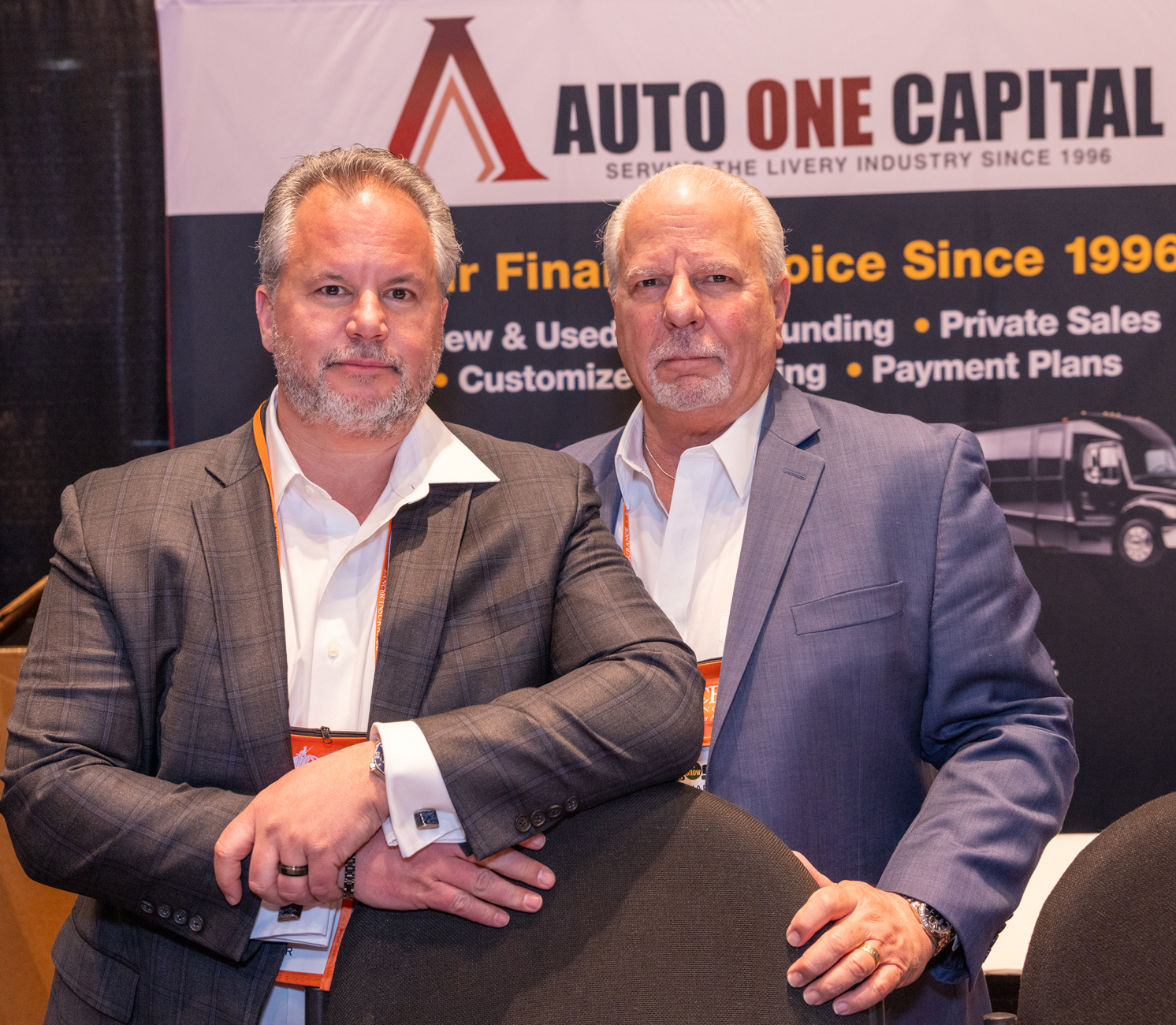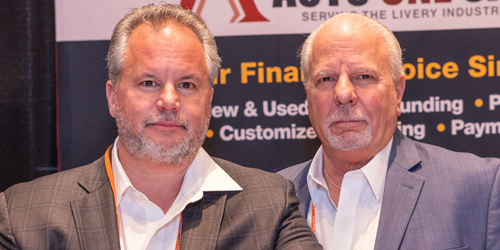Since launching Auto One Capital in 1996, Mike Villani has consistently strived to bring a human touch to commercial livery lending. For nearly 30 years, Villani has been a lending partner to countless operators across the nation, even as trends shifted, vehicles changed, and markets contracted. In 2019, Auto One Capital became a true family business as Villani’s son, Mike Jr., joined the organization. The Villanis shared their thoughts with Chauffeur Driven on the economy, what’s happening with interest rates, and what might be the next big trend.
 Mike Villani, Jr. (left) and Mike Villani Chauffeur Driven: What is the state of the lending market?
Mike Villani, Jr. (left) and Mike Villani Chauffeur Driven: What is the state of the lending market?
Mike Villani: The first question we typically get asked is, “What is the interest rate?” Rates have been fluctuating quite radically in the past four or five years. I know that many operators are having difficulty with insurance, but I believe the ones that survived COVID have come back stronger and are a little more cautious.
CD: Do you still see clients with leftover COVID debt?
Mike Villani Jr.: There are some who still have EIDLs.
CD: Noticing any specific trends in the types of vehicles being purchased?
MV: The 120” limousine at one time was the go-to vehicle, now it’s almost gone. Sprinters are about 50-60 percent of what is being sold right now. Midsize buses and coach buses have also been the trend in the past few years. I have a few clients who have electric vehicles, but we don’t get many calls for them.
CD: How are you advising clients in the current market?
MV: I tell clients to think long-term before buying something. They’ll say that they’re looking to add a vehicle because they are farming out quite a bit, but I usually advise them to wait six months. Most units today are over $100,000. A Sprinter, for example, is between $130,000 and $160,000. You could be busy today and in the next six months, but you’re making a commitment for five or six years of payments. You have to look long term and at what other avenues of growth are available to you using that new vehicle.
MVJ: On the flip side, I advise clients to be prepared by knowing their bank statements, what kind of debt they have now, and what they’ve financed in the past. Often operators don’t understand what the bank looks at, so we try to educate them so that they’re not surprised. We offer a service called “Are You Bankable?” where, if needed, we recommend that they do certain things so that they’ll be better “bankable” when the time comes.
CD: Can you give examples of what is addressed in “Are You Bankable?”
MVJ: Basically, we go through questions about their business and financial history. The biggest thing is bank statements. Some operators might not keep all their money in one bank, but the lender wants to see all their revenue. Another part of it, which is a huge thing, is not leaving an adequate balance at the end of the month. The bank wants to know that there’s enough money left over every month to cover the payments. Some operators feel that a lender will give them money just because they run a good business, but that’s not how it works. If the money’s not in the bank, or it doesn’t go through the bank, the lender doesn’t count it.
CD: What else are banks looking for?
MV: These are the primary things we look at: Time in business, revenue in their bank account, the customer’s personal credit, and their ability to pay. With those factors, we can determine whether they have to put money down or not. If someone is newer to the business, or they don’t have a strong payment history, then a down payment will probably be required. But it really is specific to the customer’s situation and overall financial health.
MVJ: It also depends upon the relationship you have with the bank. We do a lot of relationship borrowing and have many long-term clients, so the bank knows them and knows how they pay. A new customer might be approved by the bank but may require maybe 10% down just to establish that initial connection and see how they handle payments moving forward.
CD: Any predictions on interest rates in the coming year?
MV: It’s tricky to predict. The problem is, the current administration and the Fed don’t really get along, so things are all over the place. When the prime rate fell, interest rates went down for maybe 30 days and then went right back up. My best guess is that rates will be roughly the same a year from now, but a lot depends on what happens in the next six months or so with inflation and the economy. There are a lot of unknowns.
CD: How are lending institutions reacting to the tariff talks?
MV: It’s too soon to tell. Currently, there’s no difficulty getting financing, as long as they qualify for it. I see many people who are cautious about what they’re going to do, and I can’t blame them. They want to wait and see how this is all going to develop.
MVJ: As long as borrowers are paying, banks will lend. There are always different banks that come in and out of the space. My father has been steadily focused on this industry for the past 30 years, so that’s one thing we hope people look for when considering a lender.
CD: Do you think the used market will rebound again if the tariffs kick in?
MVJ: That might happen if the cost of entry rises significantly on the new car end. If there are no new cars available and you have to pay $10,000 over sticker, then the used car market for that particular product goes up. If it does happen, it will take a little time because there’s still stock on the ground.
CD: Are there advantages to leasing versus owning?
MV: Most of our customers purchase, but we can do both. Commercial leasing and commercial purchasing are pretty much the same in terms of payments, but when someone asks about leasing, I defer them to their accountant who knows how their tax structure is set up. When you lease privately, it’s typically a term of three years, after which the vehicle goes back to the dealership, and you move on. Commercial leasing is different. The residual value is either $1 or a very low amount that you’re required to pay at the end of the term because the dealer isn’t taking the car back. It’s really based on how their company is structured and how depreciation of that equipment is handled. In some states, it’s an advantage to lease because of how their taxes are paid.
CD: What do you predict for the industry in the next five years?
MV: There have been several metamorphoses of the transportation industry, from limos to Sprinters to buses. Coach buses were once a completely different industry, and unless there’s a magical new product that hits in the new few years, Sprinters are going to continue to be popular.
MVJ: The only thing I’d add is that insurance might continue to be an issue, which could push some smaller operators out and increase bigger operations. If you can’t absorb a 30% increase in insurance, you might go out of business.
CD: Do you see the same consolidation in lending that you do in insurance?
MVJ: No. Lenders come and go, and they’ll leave if they get hurt a bit, but it’s different for insurance companies. They have a lot more regulations that they have to meet, and their potential losses are bigger. If a lender has to take back a $150,000 vehicle, and they recoup $100,000, they’re only negative $50,000. However, the insurance company could be on the hook for $3 million for just one lawsuit, which could force them out of business.
CD: Best advice for building a relationship with a lender?
MVJ: I always tell customers not to be afraid to ask questions. If you’re not sure about how things work, we can walk you through it. We’re just two guys, a father and son, who are happy to help. Use us as a free resource, whether you work with us in a year, two years, or not at all. We’re a relationship bank; we try to maintain good relationships with our customers so they can grow from one or two vehicles to 100, if that’s what they want. It’s very important to us that our portfolio performs well, which means that everyone is in the right unit, growing their business, and can afford to pay. Where other banks might just get your money and run, that’s not how we look at things—that’s why we talk to the operator before they buy the vehicle to be sure they need it and have the revenue to sustain it. We’re kind of consultants in that way.
MV: I’ve been doing this for 29 years, and it’s not like I’m looking to do a one-off. We have clients who have been with us for 25+ years, so we like to think of ourselves as your partner and not just a bank. We want to give you all the tools you need to succeed. [CD0325]
Q&A With Auto One Capital
- Details


